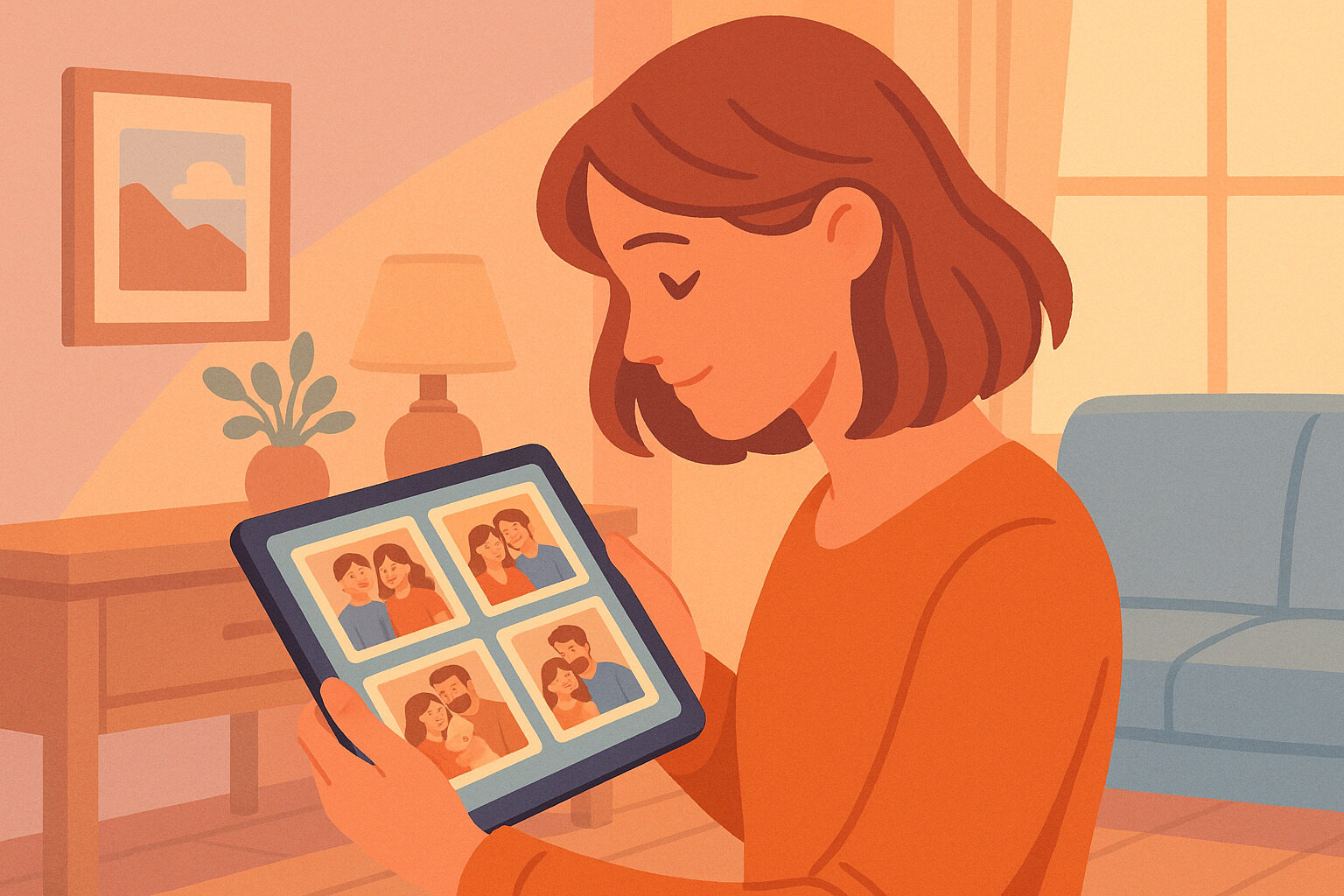
Making Space for Stories That Matter
Photos aren’t just pictures—they carry the moments that shape families, friendships, and shared experiences. Whether it’s a wedding day, a road trip, or just a quiet afternoon with someone you love, those memories deserve more than a folder on a phone. How to build a memory wall with digital displays starts with bringing those memories to life, creating a living space filled with emotion and meaning.
Unlike traditional frames, digital displays allow for rotation. You don’t have to choose just one picture from a special day. Instead, you can share an entire collection, letting the display shift from one memory to the next. This adds life and movement to a wall that once held still images.
Creating your own memory wall can be simple or detailed. What matters is making it feel like a part of your home—not just a tech feature, but something that holds the people and moments that mean the most.
Picking the Right Spot for the Memory Wall
Before you hang any screens, think about where this wall should go. A hallway might offer a natural flow for visitors to pause and enjoy the memories. A living room corner might be ideal for family photos that play during quiet evenings. It’s all about choosing a space that invites attention without being overwhelming.
You’ll also want to consider lighting. Glare can affect how well photos display, especially on glossy screens. A spot with soft, indirect light works best. Since this setup often contributes to memory mosaics, ensuring that the display is both beautiful and functional is key. If you’re using touch-enabled displays, make sure the wall is easy to reach, especially for guests who might want to scroll or interact. These placement and lighting choices are essential steps in how to build a memory wall with digital displays that feels both inviting and practical.
This project works best when it feels intentional. Planning the space with care helps avoid clutter and makes each screen feel like a window into something meaningful. Whether it’s a grid, a column, or an open layout, make sure the final design suits the room and the rhythm of your daily life.
Choosing the Best Type of Digital Displays
There are many options when it comes to digital photo frames. Some connect to Wi-Fi and update in real-time. Others rely on USB sticks or SD cards. The right choice depends on how hands-on you want to be and how often you want to update what’s shown.
For families who like sharing photos across distance, cloud digital photo frames make things easy. Grandparents can see pictures of the grandkids almost instantly. For more private or offline use, a standalone frame with local storage might be better suited. Considering these options is an important step in how to build a memory wall with digital displays, ensuring the technology matches both your needs and your style of sharing.
The size and resolution matter too. Larger displays show more detail but take up more wall space. Smaller ones blend into a gallery-style setup. High-resolution screens make colors pop, especially for nature shots or vibrant events like parties or celebrations.
Organizing Digital Albums for Display
One of the best features of digital displays is how flexible they are. You’re not stuck with one photo per frame. Instead, you can group images into playlists or albums—organized by date, event, or even person.
Think about the story you want the wall to tell. You might have one screen playing vacation photos while another shows family milestones like birthdays or graduations. You can even add captions, dates, or quotes to give context to what’s being shown.
If your frame allows app-based uploads, it’s easy to update your wall weekly or monthly. You can also create themed albums for holidays, anniversaries, or seasons—adding fresh meaning as time passes and new memories are made.
Wiring and Power Without the Clutter
One challenge with digital frames is managing the power cords. If you’re using several displays, you’ll want to think about how to hide wires and maintain a clean, finished look. Some people use in-wall cable kits, while others run cords behind furniture or baseboards.
Battery-operated frames offer a cleaner setup, but they often need regular charging and may not stay on as long. For a more permanent solution, use frames with low-profile plugs that fit behind the screen. Cord covers can also help keep everything tidy and safe.
The goal is to let the photos shine without distraction. Taking time to plan the layout, power sources, and wire paths ahead of time makes a big difference in the final look of your memory wall.
Blending Digital With Traditional Decor
A memory wall doesn’t have to be all digital. In fact, combining digital frames with printed photos, artwork, or personal items adds warmth and texture. Mixing formats can soften the tech edge and turn the wall into a true storytelling space.
You might hang a shadow box beside a digital frame, or place a small shelf with a keepsake underneath a rotating display. This approach invites guests to pause longer and engage with more than just the screen. It becomes a layered reflection of what matters most.
Balance is the key. Too many screens in one place can feel cold or crowded. But blending one or two digital displays with framed prints or handmade pieces can create something both beautiful and personal.
Customizing Playback and Display Settings
Most digital frames come with playback controls—how long each photo stays on screen, whether transitions fade or slide, and what times the display turns on and off. Customizing these settings makes your wall feel more thoughtful and less generic.
Set your frames to display photos at times when people are around to enjoy them. Maybe they turn on in the evening when the family gathers, or during the weekend when guests are over. You can even set certain albums to play only on special dates.
Adding music or background sound is another option for some frames. A quiet soundtrack during a slideshow of wedding photos or a child’s early years can add an emotional touch that brings those moments back to life.
Adding Video and Animated Memories
While still photos carry deep meaning, short videos can capture laughter, movement, and the sound of voices. Some digital displays support video clips, allowing you to include snippets of first steps, family vacations, or shared meals.
Videos should be short and loop smoothly so they don’t disrupt the flow of the wall. A 10-second clip of a dance, a wave, or a moment of silliness can be more powerful than a single image. Keep the sound off or use subtitles if the display is in a quiet area.
If you’re using multiple displays, consider assigning one to video and the rest to stills. This keeps the wall dynamic without overwhelming the senses. Carefully chosen clips can add new layers to the memories already on screen.
Updating the Wall Over Time
A memory wall should grow along with your life. What starts as a few favorite photos can expand into something that tells the story of years. Updating your digital albums regularly keeps the wall fresh and reflects the moments that matter now.
Set a schedule to update monthly or seasonally. It doesn’t have to be a big task. Uploading a handful of new photos after a birthday or weekend trip keeps the content current and makes the wall feel alive. Rotating old albums also helps keep things balanced.
Some people like to save their favorite photos in a permanent album that always plays. Others rotate everything. Choose what works for your lifestyle—but don’t let the wall get stale. Part of the magic is watching it change over time.
A Living Display of Life’s Most Loved Moments
Building a memory wall with digital displays brings people and stories into everyday view. It transforms blank space into something rich with meaning. Every time someone walks by and sees a photo or a video that sparks a smile, the wall does its job.
This kind of setup isn’t just about tech—it’s about staying close to the people and times that make life worth remembering. From quiet mornings to noisy celebrations, the memories held on this wall turn into part of the room’s heartbeat.
A memory wall reminds us where we’ve been, who we love, and how much we’ve grown. And sometimes, that’s exactly what a home needs—which is why learning how to build a memory wall with digital displays can help you create a space that keeps those moments alive every single day.

